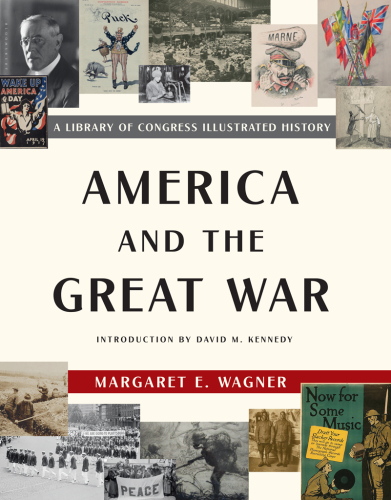
America and the Great War
A Library of Congress Illustrated History
کتاب های مرتبط
- اطلاعات
- نقد و بررسی
- دیدگاه کاربران
نقد و بررسی

March 13, 2017
Wagner (The Library of Congress Illustrated Timeline of the Civil War), a senior editor and writer at the Library of Congress, uses the library’s visual and documentary resources to good effect in a work that combines an entertaining coffee-table format with an intellectually rewarding text. America’s participation in WWI remains underreported, and most of what’s been written on the topic is aimed at specialists. Wagner effectively analyzes and explains how America absentmindedly arrived upon the world’s center stage. In 1914, the U.S. was adapting, “for the most part enthusiastically,” to an unprecedented spectrum of social, economic, and political change. Europe’s squabbles seemed impossibly remote. Wagner outlines the symbiotic entwining of America’s domestic transformations, the processes that led millions of Americans to become enthusiastic war hawks, and President Woodrow Wilson’s use of progressive principles and executive power to lay the foundation for an administrative democracy. The linking of state authority with popular support would shape the U.S. for a century. Meanwhile, there was a war to be won, and America’s contribution was decisive, though Wilson provided less operational support during wartime than influence in the war’s aftermath. Wagner thoughtfully lays out Americans’ struggles to coherently process “nineteen months of patriotic endeavors and furious upheaval”—a disconnect that ultimately frustrated Wilson’s attempt to cast himself as “an arbiter of peace.” Illus.

March 15, 2017
The latest installment of the Library of Congress' series of illustrated histories and timelines, this one focusing on World War I.Beginning in 1912, Wagner (The Library of Congress Illustrated Timeline of the Civil War, 2011, etc.), a senior writer/editor at the LOC Publishing Office, describes the isolationism gripping the United States; many citizens, experiencing a wave of societal changes, were distrustful of a standing army. With the speedy growth of invention--e.g., electricity, cars, planes, telephones, moving pictures--income inequality and labor relations exacerbated anger and friction. The war wasn't much of a surprise after the Balkan Wars exposed interference from both Turkey and Russia, making Austria-Hungary nervous. America faced her own threats. The Mexican Revolution spilled over into Texas, raising demands that Wilson send in troops. Here, as she does throughout, Wagner depicts events not often given sufficient coverage in history books. Mexico pushed us toward war, with lots of prodding from Germany, and Japan was taking its turn saber-rattling in the Pacific. Many pacifist Americans spoke out against the war, including Jane Addams, Henry Ford, and Sen. Robert La Follette. When war did break out, Americans rushed to send aid but refused to join. Wilson and Congress, fearing a fifth column, passed the Espionage Act in 1917, which quickly exposed poor intelligence services that relied on informers and vigilantes convicting the innocent. Germany's decision to return to unrestricted U-boat warfare in 1917 reminded Americans of the sinking of the Lusitania in 1915. But the tipping point was the Zimmerman telegram, which proposed an alliance between Germany and Mexico. The author elaborates on how little help the U.S. provided at first; lack of equipment, the need for conscription, and lack of boats to transport them were only parts of the problem. The troops were trained, finally, but not in methods useful in the trenches. A fresh, enlightening look at American society as it reluctantly worked its way into being a world power--most valuable to historians and sociologists.
COPYRIGHT(2017) Kirkus Reviews, ALL RIGHTS RESERVED.

























دیدگاه کاربران